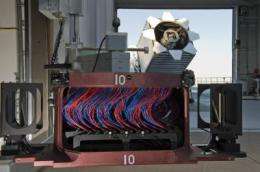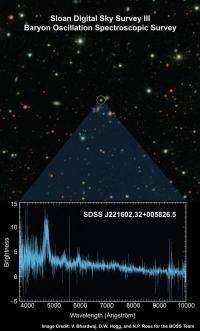First light for BOSS -- a new kind of search for dark energy

BOSS, the Baryon Oscillation Spectroscopic Survey, is the most ambitious attempt yet to map the expansion history of the Universe using the technique known as baryon acoustic oscillation (BAO). A part of the Sloan Digital Sky Survey III (SDSS-III), BOSS achieved "first light" on the night of September 14-15, when it acquired data with an upgraded spectrographic system across the entire focal plane of the Sloan Foundation 2.5-meter telescope at Apache Point Observatory in New Mexico.
BOSS is the largest of four surveys in SDSS-III, with 160 participants from among SDSS-III's 350 scientists and 42 institutions. BOSS's principal investigator is David Schlegel, its survey scientist is Martin White, and its instrument scientist is Natalie Roe; all three are with the Physics Division of the U.S. Department of Energy's Lawrence Berkeley National Laboratory. Daniel Eisenstein of the University of Arizona is the director of SDSS-III.
"Baryon oscillation is a fast-maturing method for measuring dark energy in a way that's complementary to the proven techniques of supernova cosmology," says Schlegel. "The data from BOSS will be some of the best ever obtained on the large-scale structure of the Universe."
BOSS's first exposure was made after many nights of clouds and rain in the Sacramento Mountains when spectroscopy was obtained of some 800 galaxies and 200 quasars in the constellation Aquarius. Team member Vaishali Bhardwaj, a graduate student at the University of Washington fresh from a summer internship at Berkeley Lab, helped operate the telescope. Bhardwaj's teammate, Berkeley Lab postdoc Nic Ross, quipped that given the constellation where first light was obtained, the accomplishment marked the "dawning of the Age of Aquarius."
Measuring baryon oscillations
Baryon oscillations began as pressure waves propagated through the hot plasma of the early universe, creating regions of varying density that can be read today as temperature variations in the cosmic microwave background. The same density variations left their mark as the Universe evolved, in the periodic clustering of visible matter in galaxies, quasars, and intergalactic gas, as well as in the clumping of invisible dark matter.
Comparing these scales at different eras makes it possible to trace the details of how the Universe has expanded throughout its history - information that can be used to distinguish among competing theories of dark energy.
BOSS will measure 1.4 million luminous red galaxies at redshifts up to 0.7 (when the Universe was roughly seven billion years old) and 160,000 quasars at redshifts between 2.0 and 3.0 (when the Universe was only about three billion years old). BOSS will also measure variations in the density of hydrogen gas between the galaxies. The observation program will take five years.
"BOSS will survey the immense volume required to obtain percent-level measurements of the BAO scale and transform the BAO technique into a precision cosmological probe," says survey scientist White. "The high precision, enormous dynamic range, and wide redshift span of the BOSS clustering measurements translate into a revolutionary data set, which will provide rich insights into the origin of cosmic structure and the contents of the Universe."

Existing SDSS spectrographs were upgraded to include new red cameras more sensitive to the red portion of the spectrum, featuring CCDs designed and fabricated at Berkeley Lab, with much higher efficiency than standard astronomical CCDs in the near infrared.
"Visible light emitted by distant galaxies arrives at Earth redshifted into the near-infrared, so the improved sensitivity of these CCDs allows us to look much further back in time," says BOSS instrument scientist Roe.
To make these measurements BOSS will craft two thousand metal plates to fit the telescope's focal plane, plotting the precise locations of two million objects across the northern sky. Each morning astronomers begin plugging optical fibers into a thousand tiny holes in each of the "plug plates" to carry the light from each specific target object to an array of spectrographs.
Glitches met and surmounted
Steering each optical fiber to the right CCD was no trivial task, says Schlegel. "The new BOSS fiber cartridges are snake pits of a thousand fibers each. It would be a disaster if you didn't know which one went where."
With a thousand holes in each plug plate, stopping to seek out specific holes to plug a fiber into, or tracing where each fiber ends up, would take an impossibly long time. Instead a computer assigns the correct target identity to each fiber as a fiber-mapping laser beam moves over the plugged-in fibers and records where the light from each emerges.
Fast and simple - but not quite foolproof. "In our first test images it looked like we'd just taken random spectra from all over," Schlegel says. After some hair-pulling, the problem turned out to be simple. "After we flipped the plus and minus signs in the program, everything worked perfectly."
Now BOSS is on its way to generating data of unprecedented precision on two million galaxies and quasars, and density variations in the intergalactic gas. The SDSS tradition of releasing data to the public will continue, with the first release from SDSS-III planned for December 2010.
Source: Lawrence Berkeley National Laboratory (news : web)



















